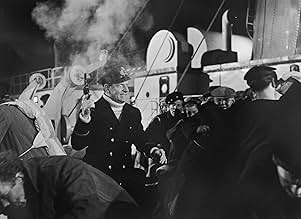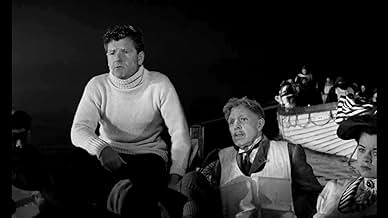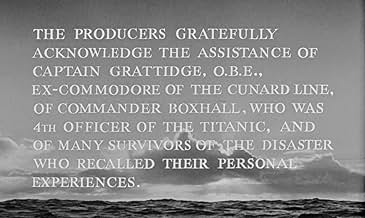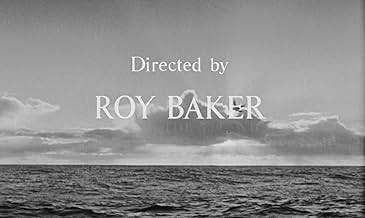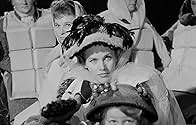Lors de son voyage inaugural en avril 1912, le prétendument insubmersible Titanic heurte un iceberg dans l'océan Atlantique.Lors de son voyage inaugural en avril 1912, le prétendument insubmersible Titanic heurte un iceberg dans l'océan Atlantique.Lors de son voyage inaugural en avril 1912, le prétendument insubmersible Titanic heurte un iceberg dans l'océan Atlantique.
- Réalisation
- Scénario
- Casting principal
- Nomination aux 1 BAFTA Award
- 2 victoires et 3 nominations au total
Avis à la une
These comments on the more recent film are necessary before I can meaningfully report my impressions when watching ANTR Although filmed in monochrome and created with a much more modest budget, ANTR is a film that I will find it very hard to forget. Characterisation of both the passengers and crew seemed to me to be spot on, there were none of the occasional caricatures which jarred so severely in the later film. The drama of the events was left to speak for itself and this created a much more powerful film. The three aspects of the Titanic disaster which have gripped public interest so strongly for almost a century are the sudden impact on a community of 2,000 ordinary people from all stations in life as they gradually realize that they probably only have another hour to live, the impact of the rigid class structures of the period on the way in which this situation was handled both by the passengers concerned and by those in authority, and the enormous number of "what if?" questions that the disaster raised (such as what effect pressure to win the Blue Riband for the fastest Atlantic crossing may have had on the seamanship shown by the officers). All three of these aspects are fully featured in the film, but often in quite subtle ways, and none is given excessive weight. The camera-work and attention to details of presentation, such as the creaking and groaning from the tortured ship, are truly outstanding. Special effects in the 1997 film are admittedly much superior (after all $200 million must buy something!), but those in ANTR are quite advanced for its time and are more than adequate to prevent any serious jarring notes from arising as the film is viewed. Ultimately a film has to be judged primarily by the credibility of the acting and direction, not from the special effects, and I certainly support the view of the majority of IMDb users that these raise ANTR to the status of an exceptionally fine, if not almost unique, movie. A documentary presentation of a major marine disaster which is realistic enough to closely involve most of its viewers will never be everybody's choice of film to watch; but for those who wish to see it, this film will provide an exceptionally rich viewing experience.
TITANIC (1915) TITANIC: DISASTER IN THE ATLANTIC (1929) TITANIC (1943) TITANIC (1953) A NIGHT TO REMEMBER (1958) SOS TITANIC (1979) TITANIC (1984) TITANIC (1996) TITANIC (1997)
The REASON that A NIGHT TO REMEMBER excels, is that it is a straight up docudrama of the event. Historical accuracy (lets forget the "split,"... although actually "suggested" by a few eye-witnesses at the time, it was believed the ship had foundered intact) was observed, the main characters were vastly better portrayed than in later films and the "scale" of the disaster far more keenly felt, for all James Cameron's $180 million! Kenneth More made an unimprovable-upon Captain Lightoller and Laurence Naismith simply WAS Captain Smith. (The less said about Bernard Hill's loopy characterization in Cameron's epic, the better!) Those who wish to compare multi million dollar digitization to that which was available in 1958 need to get REAL and for all that money, and exciting as Cameron's was - it just didn't either LOOK or feel anything more than, well...a massive film-set! The 1958 version went to the heart of the tragedy...and took the viewer with them. A NIGHT TO REMEMBER will remain a tribute...THE tribute to that night of madness. Little things, David McCallum fighting for his life-vest, Michael Goodliffe as Thomas Andrews - dignity personified waiting for his last moments, the drunken cook - they were all worth more than $100 million dollars worth of fx! You can't BUY credibility. This could never have been an American tale - it didn't work with the 1953 Barbara Stanwyck version and it didn't ring true for Cameron (good though it was as a movie rather than as the tragedy!) Did anyone notice dear old "Q" (Desmond Llewelyn) below decks and old Brit-turned-Aussie favorite Stuart Wagstaff, as a steward in Steerage?
Often movies that try to stay close to the facts suffer from a lack of focus, especially when there is/are no central character(s) to hold things together. In this adaptation of "A Night to Remember", they solved the problem by focusing much of the action around Second Officer Lightoller, who was involved in some way in so many different aspects of what happened. As a device it works well, and there is enough action involving the other characters to keep it balanced.
Another inherent challenge in the story is that there are so many characters, and most of them hold some interest. In this adaptation, they chose simply to depict as many brief situations as possible, often without giving much with which to identify the characters. If you are familiar with Walter Lord's book, it is often possible to identify many of them, but otherwise, it might be a little confusing to sort through so many characters.
For such a detail-heavy story, this is an effective and commendable movie. With very few frills, it tells the story believably and sometimes memorably.
It does a pretty good job of meeting the main challenges, not telling the complete story, of course, but providing a worthwhile overview of events.
The style is semi-documentary from a book by Walter Lord, an American journalist who had actually travelled as a child on the "Olympic." Hence time and place are evoked seamlessly even if the representation of the ship using small models and back projection does not match Cameron's 9/10ths scale replica. Filming is in black and white, wholly appropriate as most of the action is at night, and there's not a bad performance from any of the large cast, several of whom went on to greater things.
All the story is there - the elegant huge new liner with passengers and crew neatly divided by class, the reckless overconfidence (21 knots into an icefield when several other ships had radioed they had stopped nearby,) the ignored ice warnings, the strange behaviour of the Captain of the nearby "Californian," the general heroism of the "Titanic's" officers and crew, and the lovers, young and old, who would not be parted.
Anyone who came out of Cameron's film feeling vaguely cheated (as I did) should see this movie for a much better presentation of the story, and a vastly better script. Not that that would have been hard - Cameron was a mug to write "Titanic" himself - his talents lie elsewhere, in appealing to the chimpanzee (primal fear) in all of us. The current interest in a shipping disaster which occurred 86 years ago does suggest it has a broader cultural significance than our desire to experience vicarious danger at the movies. "A Night to Remember" at least give some basis for thoughtful reflection.
Le saviez-vous
- AnecdotesIt wasn't until 1985, when the wreckage of the Titanic was discovered, that they found out the ship had broken in two while sinking. In this film, the Titanic does not break in two, but goes down in one piece with most of her decks intact.
- GaffesAs with most pictures about the Titanic, filmed before the discovery of the wreck in 1985, this film portrays the Titanic sinking in one piece. The discovery of the wreck revealed that the ship had broken in two, and most films about the ship, Le Titanic (1996) and Titanic (1997), have reflected this point. Although scholars debate to this day whether the break up happened while the ship was above the water line or while it was under the water, and out of the view of survivors, plunging towards the ocean floor. Eyewitness testimony to the sinking diverges in opinion about this fact, meaning that the movie's portrayal of the ship sinking intact, while above the water line, may not be incorrect.
- Citations
Mrs. Margaret 'Molly' Brown: Leadville Johnny, they call him. And he was the best golderned gold miner in Colorado! Fifteen I was when I married him.
First Class Passenger: Really?
[in deep upper-class British accent]
Mrs. Margaret 'Molly' Brown: Uh-hmm. And he didn't have a cent. Well, three months later later he struck it rich and we was millionaires. Do you know what he did?
First Class Passenger: No?
Mrs. Margaret 'Molly' Brown: He built me a house and he had silver dollars cemented all over the floors of every room!
First Class Passenger: I say, how very tiresome for you!
- Crédits fousJust before "The End", the following is scrolled over a background of the water with flotsam and a life ring buoy with the words "Titanic" and "Liverpool" on it:
But this is not the end of the story ~ for their sacrifice was not in vain. Today there are lifeboats for all. Unceasing radio vigil and, in the North Atlantic, the International Ice Patrol guards the sea lanes making them safe for the peoples of the world.
- Versions alternativesThe 2012 ITV Studios DVD and Blu-ray features epilogue text at the end as well as the moment with the child.
- ConnexionsEdited from Titanic (1943)
- Bandes originalesOff to Philadelphia
(uncredited)
Traditional
Played on violin and sung by Titanic passengers
Meilleurs choix
Détails
- Date de sortie
- Pays d’origine
- Langues
- Aussi connu sous le nom de
- La légende du Titanic
- Lieux de tournage
- Great Fosters Hotel, Egham, Surrey, Angleterre, Royaume-Uni(Sir Richard and Lady Richard set off from their mansion to board the Titanic at Southampton)
- Sociétés de production
- Voir plus de crédits d'entreprise sur IMDbPro
Box-office
- Budget
- 1 680 000 $US (estimé)
- Montant brut mondial
- 712 $US
- Durée
- 2h 3min(123 min)
- Couleur
- Rapport de forme
- 1.66 : 1


